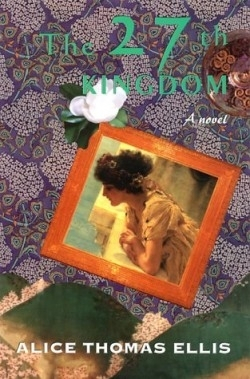The 27th Kingdom
From very early on, the novel’s main characters note Valentine’s “difference.” Omniscient, kind and startlingly beautiful, she possesses unusual sensibilities. Her migration to England from the Caribbean to become a nun is enigmatic: this is no trip to attend college or send money home to help impoverished relatives. Is she there to “fulfill a role more nearly and precisely than others” by atoning for the death of British tourists at her sister’s hands? Is she there to transform the lives of the immoral/amoral group with whom she lives? Or is she salvation in strange form?
When the apple that she picks in the convent’s orchard refuses to rot, Mother Superior assumes that like Valentine, it is not ready to “conform to the laws of nature.” Thus, to prepare her for the cloistered life, Mother Superior sends her to live with her relatives and their colorful friends. Even there, Valentine shines—literally. The thieving Mrs. O’Connor sees Valentine’s form outlined in light “dark as a painted saint” when she stands in the church. Valentine mysteriously disappears whenever Kyril attempts to seduce her. Aunt Irene notes that Valentine seems to know everything, and Mr. Mason, in his brief hiatus from alcoholic drink, sees Valentine fly. Moreover, she seems to redeem her sister’s wrong by saving the surviving relative of the ill-fated tourists through breathing him—quite literally—back to life.
Yet who is Valentine—really? The only sign of pure goodness in the lives of the novel’s ribald characters, she affects them profoundly. Yet what we know about Valentine comes largely from those around her. It is implied that she is genteel because she is a “half-caste.” Aunt Irene wonders if her happy demeanor is due to her tropical origins. The others imagine picaninnies and cane fields when they think of her culture. That they seldom ask Valentine about herself and tend to project their images of her onto her is not surprising.
The author carefully builds the characters? intensely superficial natures throughout the piece. Yet, our brief glimpse into Valentine’s interior life suggests that she is not shallow herself. Because she seldom speaks or thinks in the novel, however, she is always a strangely unreal presence—one made problematic by her race and her gender. Perhaps it is the novelist’s intention to demonstrate Valentine’s moral superiority midst the all white cast, but it unwittingly backfires. Valentine’s unrelenting sensuality and island “exoticism” and her possession of strange powers resemble the sexual, strangely powered and mystical stereotype of the Caribbean woman (Bertha Mason et al) in Western fiction. Both images present the Caribbean woman as other. Neither woman exists.
It is a remarkable though somewhat confusing tale indeed, riddled with believable characters, clever dialogue and a host of spiritual and spirited moments. Ellis has produced a charming moral/amoral fable, but it still begs the question, who is Valentine—really?
Disclosure: This article is not an endorsement, but a review. The publisher of this book provided free copies of the book to have their book reviewed by a professional reviewer. No fee was paid by the publisher for this review. Foreword Reviews only recommends books that we love. Foreword Magazine, Inc. is disclosing this in accordance with the Federal Trade Commission’s 16 CFR, Part 255.

